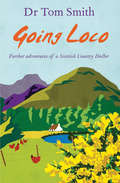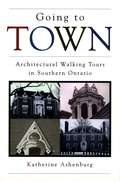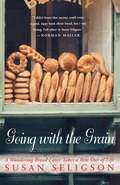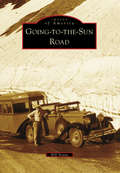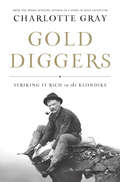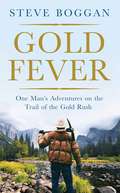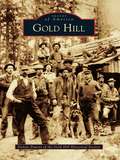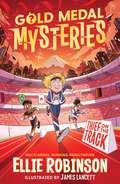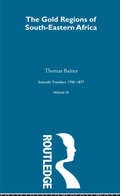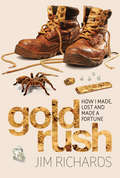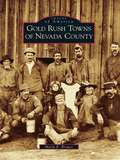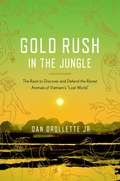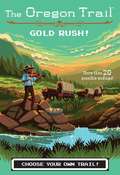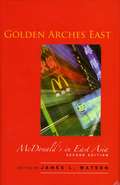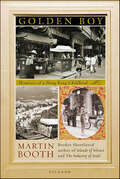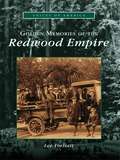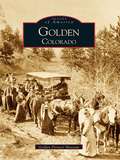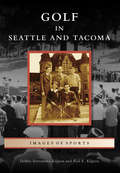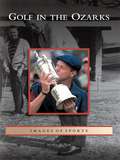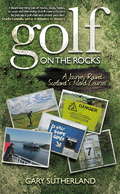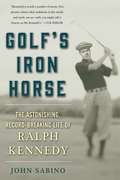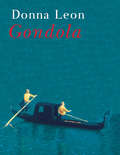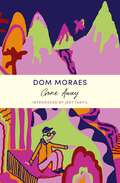- Table View
- List View
Going Loco: Further Adventures of a Scottish Country Doctor
by Dr Tom SmithPart memoir, part travelogue, Going Loco takes us on a dizzying journey around the medical world. It is a gripping read, full of the colour and charm of Dr Tom's previous book - this young doctor on the move is great company.
Going Solo
by Celebration PressPeople go on journeys by themselves for many reasons. Often they want to prove that they can do it, or they travel for the excitement of the journey. Going Solo explores the journeys of four people, each of whom had an adventure in a different part of the world.
Going to Town: Architectural Walking Tours in Southern Ontario
by Katherine AshenburgWinner of The Ontario Historical Society’s Fred Landon Award for Best Regional History. With 300 photos and 11 maps. A work of unexpected delights and surprises: here is a one-of-a-kind guidebook that pinpoints the best of Ontario’s architectural heritage in its most charming towns, offers tantalizing and informative details of provincial history, indulges the near universal vice of real-estate voyeurism, and beckons even the most reluctant to physical exercise. Katherine Ashenburg is our knowledgeable and charmingly opinionated companion on walking tours of ten small (populations 1000 to 27,000) Ontario communities that provide a rewarding variety of domestic and public architecture in a walkable compass. Each tour begins with a brief historical sketch of the town, then, with the aid of a detailed map, guides the reader/walker to some 60 sites over a leisurely but carefully plotted two-and-a-half to three-and-a-half hour stroll. We visit churches and jails, libraries and town halls, theatres and factories, and all manner of houses - homes of startling grandiosity and humble integrity. We become conversant with belvederes and ogee arches, Flemish bond and board and batten, at ease with Regency and Queen Anne, Italianate and Romanesque. And along the way, Ashenburg reveals the town’s true personality, its distinctive architectural styles, forms and materials, and the genius, ambition, and vanities of its founders and builders. Every town - Perth, Picton, Cobourg, St. Mary’s, Niagara-on-the-Lake, Merrickville, Port Hope, Paris, Stratford and Goderich - is a day’s excursion from Toronto by a car or public transit; most are day-trips from either Ottawa or London. Over 300 black and white photographs capture the highlights; 11 maps show the way. For easy reference, there is a helpful, illustrated Guide to Historical Styles and an exhaustive Glossary of Architectural terms - everything from Apse to Voussoir.
Going with the Grain
by Susan Seligson"My lifelong love affair with bread has less to do with crust, crumb, and the vagaries of sourdough cultures and more to do with bread as a reflection of people's varied beliefs, daily lives, and blood memories....Bread tells the most essential human stories." So begins Susan Seligson's personal and often humorous journey to discover the secrets of the baker's trade and the place bread has in the lives of those who consume it. Part travelogue, part cultural history, with a handful of recipes thrown in for good measure, it is an exploration of the customs, traditions, and rituals around the creating and eating of this most basic and enduring form of sustenance. Bread is the stuff of life. Governments have been overthrown and religious rituals created because of it. Fry bread, matzo, ksra, nan, baguette: all are as resonant of their specific culture as any artifact. In Going with the Grain, Seligson wanders the streets of the Casbah in Fès, Morocco, to unlock the secrets of the thousand-year-old communal bakeries there. In Saratoga Springs, New York, she finds a bread maker so committed to making the ultimate loaf, he built a unique sixty-ton hearth and uses only certified biodynamically grown wheat. Seligson knelt in the Jordanian desert beside a woman turning flat breads over glowing embers and plumbed the mysteries of Wonder Bread in an aseptic American factory. As satisfying as a slice of good bread with butter, Going with the Grain is for the armchair traveler and armchair baker alike.
Going-to-the-Sun Road
by Bill YenneThe Going-to-the-Sun Road is rightfully recognized as one of the most spectacular alpine highways in the world and certainly among those in the United States. The landscape is one of peerless beauty, but the road itself is an engineering masterpiece. In 1910, Glacier National Park was created in that million-acre swath of mountains, lakes, and glaciers that the great naturalist George Bird Grinnell called "the Crown of the Continent." Soon, plans were being made for a road that would take visitors into the heart of this amazing place. The result was the Going-to-the-Sun Road, which has been the centerpiece of the visitor experience in Glacier since it was formally dedicated in 1933.
Gold Diggers: Striking It Rich in the Klondike
by Charlotte GrayBetween 1896 and 1899, thousands of people lured by gold braved a grueling journey into the remote wilderness of North America. Within two years, Dawson City, in the Canadian Yukon, grew from a mining camp of four hundred to a raucous town of over thirty thousand people. The stampede to the Klondike was the last great gold rush in history.Scurvy, dysentery, frostbite, and starvation stalked all who dared to be in Dawson. And yet the possibilities attracted people from all walks of life-not only prospectors but also newspapermen, bankers, prostitutes, priests, and lawmen. Gold Diggers follows six stampeders-Bill Haskell, a farm boy who hungered for striking gold; Father Judge, a Jesuit priest who aimed to save souls and lives; Belinda Mulrooney, a twenty-four-year-old who became the richest businesswoman in town; Flora Shaw, a journalist who transformed the town's governance; Sam Steele, the officer who finally established order in the lawless town; and most famously Jack London, who left without gold, but with the stories that would make him a legend.Drawing on letters, memoirs, newspaper articles, and stories, Charlotte Gray delivers an enthralling tale of the gold madness that swept through a continent and changed a landscape and its people forever.
Gold Fever: One Man's Adventures on the Trail of the Gold Rush
by Steve BogganOne Thursday in 2008 the price of gold went above a thousand dollars an ounce for the first time in history. All over the world, at least in countries with gold-bearing soil, people with no experience of prospecting began shopping for shovels and pickaxes, gold pans, tents, generators and all manner of equipment they had no idea how to use. And off they went mining.Steve Boggan followed them, packing his bags and flying to San Francisco to join the 21st century's gold rush in a quest to understand the allure of the metal - and maybe find a bit for himself, too. He also takes us back in time to the original San Fransiscan gold rush, two centuries ago, and gets a crash course in the science and economics of gold. Written with Boggan's characteristic wit and self-effacing charm, Gold Rush is a hugely entertaining travelogue and a unique insight into the history and future of the world's most seductive metal.
Gold Hill (Images of America)
by Gold Hill Historical Society Dennis PowersGold Hill is a product of the frontier days, when bold men sought golden riches despite ongoing hardships. The 1860 discovery of the famous Gold Hill Pocket, overlooking the present townsite, brought about its name with a gold rush that continued for decades and spilled into the nearby creeks and valleys, including mines with names like the Millionaire, Lucky Bart, and Roaring Gimlet. In 1884, the railroad bypassed neighboring settlements, which made Gold Hill a center depot and created ghost towns along the way. While the cry of "Gold! Gold! Gold!" filled the air, women and families drove in roots that tamed the town. When the area's mining and lumbering industries phased out, Gold Hill was then rediscovered in the late 20th century by folks searching for a small-town life, exquisite surroundings, and proximity to the legendary Rogue River. Wine tasting and vineyards replaced areas where stagecoaches once stopped and orchards grew.
Gold Medal Mysteries: Thief on the Track (Gold Medal Mysteries)
by Ellie RobinsonJoin three sporting detectives as they race around the world in the brand new mystery adventure series from multi gold medal-winning Paralympian, Ellie Robinson. Hannah, Maria, and Seb are at the World Championships in Tokyo, bonding over their excitement at watching their favourite athletes compete. But Jesse Marks, a star runner on the US relay team has had his gold medal stolen! The sport park is alive with gossip and as the three new friends begin to investigate, several suspects begin to emerge. With time running out before the final race is run, can the detectives uncover who is out to sabotage the team? The race to solve the case is on in this twisting, action-packed look-behind-the-scenes at the world's biggest sporting event, with clues and illustrations throughout from James Lancett.
Gold Region:Sci Tra 1791-1877
by Thomas BainesThis book contains a preface, a memoir and an obituary notice, which together provide a good account of Thomas Baines' life. It includes advertisements aimed especially at would-be emigrants to South Africa. The book is an important document of colonial history and South African history.
Gold Rush
by Jim RichardsWhen young Jim Richards left the army to make to chase a dream, he had no language skills, no money and no idea, just the kind of gold lust that has driven fortune hunters throughout history. And when he struck gold and diamonds in the remote rivers of Guyana, his problems and his success grew in equal measure. Jim Richards has done it all: dived for diamonds in the piranha-infested rivers of South America; discovered a fabulously rich goldmine in the Australian outback; got caught up in the world's biggest mining scam in Indonesia; and even started a gold rush in the war-torn jungles of Laos.
Gold Rush Towns of Nevada County
by Maria E. BrowerNevada County is webbed with some of the richest veins of goldbearing quartz in the world. First discovered in 1849 as placer gold washed into creek beds, hydraulic miners later used massive jets of water to melt mountains and free the precious metal. Rich lodegold districts such as Grass Valley and Nevada City were the most productive in California, and innovations such as hydraulic mining began here and spread throughout the nation. Whimsical names like You Bet, Red Dog, Rough and Ready, French Corral, and Blue Tent hint at the colorful beginnings of dozens of camps that grew from wild and chaotic tent towns to bustling young communities, complete with schools, churches, and businesses. Boomtowns North San Juan, North Bloomfield, and Columbia propelled Nevada County to the head of the state's economy by 1900 and hundreds of miles of gold-bearing quartz veins continued to be tapped in underground tunnels for another 50 years or more.
Gold Rush in the Jungle: The Race to Discover and Defend the Rarest Animals of Vietnam's "Lost World"
by Dan DrolletteAn engrossing, adventure-filled account of the rush to discover and save Vietnam's most extraordinary animals Deep in the jungle where the borders of Vietnam meet those of Laos and Cambodia is a region known as "the lost world." Large mammals never seen before by Western science have popped up frequently in these mountains in the last decade, including a half-goat/half-ox, a deer that barks, and a close relative of the nearly extinct Javan rhino. In an age when scientists are excited by discovering a new kind of tube worm, the thought of finding and naming a new large terrestrial mammal is astonishing, and wildlife biologists from all over the world are flocking to this dangerous region. The result is a race between preservation and destruction. Containing research gathered from famous biologists, conservationists, indigenous peoples, former POWs, ex-Viet Cong, and the first U.S. ambassador to Vietnam since the war's end, Gold Rush in the Jungle goes deep into the valleys, hills, and hollows of Vietnam to explore the research, the international trade in endangered species, the lingering effects of Agent Orange, and the effort of a handful of biologists to save the world's rarest animals.
Gold Rush! (The Oregon Trail #7)
by Jesse WileyYou're in the middle of the Gold Rush, pioneer—and you are headed West on the Oregon Trail with hopes to strike it rich in this choose-your-own-trail experience. Travel in your large wagon train and decide whether you'll stay the course to Oregon or take The California Trail towards Sacramento. Do your choices lead to a fortune-filled future or will they lead you straight into danger? Westward ho!
Golden Arches East: McDonald's in East Asia (Second Edition)
by James L. WatsonMcDonald's restaurants are found in over 100 countries, serving tens of millions of people each day. What are the cultural implications of this phenomenal success? The widely read--and widely acclaimed--Golden Arches East argues that McDonald's has largely become divorced from its American roots and become a "local" institution for an entire generation of affluent consumers in Hong Kong, Beijing, Taipei, Seoul, and Tokyo. In the second edition, James L. Watson also covers recent attacks on the fast-food chain as a symbol of American imperialism, and the company's role in the obesity controversy currently raging in the U. S. food industry, bringing the story of East Asian franchises into the twenty-first century. Praise for the First Edition: "Golden Arches East is a fascinating study that explores issues of globalization by focusing on the role of McDonald's in five Asian economies and [concludes] that in many countries McDonald's has been absorbed by local communities and become assimilated, so that it is no longer thought of as a foreign restaurant and in some ways no longer functions as one. " --Nicholas Kristof, New York Times Book Review "This is an important book because it shows accurately and with subtlety how transnational culture emerges. It must be read by anyone interested in globalization. It is concise enough to be used for courses in anthropology and Asian studies. " --Joseph Bosco, China Journal "The strength of this book is that the contributors contextualize not just the food side of McDonald's, but the social and cultural activity on which this culture is embedded. These are culturally rich stories from the anthropology of everyday life. " --Paul Noguchi, Journal of Asian Studies "Here is the rare academic study that belongs in every library. "--Library Journal
Golden Boy: Memories of a Hong Kong Childhood
by Martin BoothAt seven years old, Martin Booth found himself with all of Hong Kong at his feet. His father was posted there in 1952, and this memoir is his telling of that youth, a time when he had access to the corners of a colony normally closed to a "Gweilo," a "pale fellow" like him. His experiences were colorful and vast. Befriending rickshaw coolies and local stallholders, he learned Cantonese, sampled delicacies such as boiled water beetles and one-hundred-year-old eggs, and participated in vibrant festivals. He even entered the forbidden Kowloon Walled City, wandered into a secret lair of Triads, and visited an opium den. From the plink-plonk man with his dancing monkey to the Queen of Kowloon (a crazed tramp who may have been a Romanov), Martin Booth saw it all---but his memoir illustrates the deeper challenges he faced in his warring parents: a broad-minded mother who embraced all things Chinese and a bigoted father who was enraged by his family's interest in "going native."Martin Booth's compelling memoir, the last book he completed before dying, glows with infectious curiosity and humor and is an intimate representation of the now extinct time and place of his growing up.
Golden Memories of the Redwood Empire
by Lee TorliattThe high-tech paradise just north of San Francisco, known as the Redwood Empire, was once a land of vineyards, chicken ranches, orchards, and dairies. Using their own words and vintage photographs, here are the stories of the area's residents and their 100 years of history, from the lost glitter of the Gold Rush to end of World War II. The stories recalled here come from the reflections of the people who kept their towns and farms running on a daily basis. Among the voices heard in these chapters are Healdsburg's Ferguson family, pioneer survivors of the westward trail, and David Wharff, who brought the first chickens to Sonoma County, helping create the World's Egg Basket. Through the great Santa Rosa earthquake of 1906, to the devastating flu epidemic of World War I, to the Santa Rosa-Petaluma "Big Game" riot of 1943, these diary, interview, and newspaper accounts cover a century of rich history in the Redwood Empire.
Golden, Colorado
by Golden Pioneer MuseumWhere The West Lives! Golden's motto sums up the colorful history of the small town set at the entrance to the storied gold fields of Colorado. The scenic valley that shelters Golden caught the notice of some of the most famed pioneers of the West: explorer Major Stephen Long, world traveler Isabella Bird, showman Buffalo Bill Cody, and brewer Adolph Coors. Chronicled here in over 200 vintage images is the history of this quintessential "rough-and-ready" Western town. Serving as the territorial capital from 1862-1867, Golden was primed as the perfect business opportunity due to its proximity to the mining districts. Entrepreneurs with a vision of Manifest Destiny worked diligently to civilize the frontier town, and it soon became a major player in the state's mineral extraction, education, and railroad industries. Boasting more saloons than any other structure in town, Golden also had its share of coal mines, gold smelters, a paper mill, and several railroad lines. Featuring many historic images of the town's past, including original panoramic views by William Henry Jackson and images of Buffalo Bill Cody's Masonic funeral, this book captures the heart of a town where the spirit of the West never died.
Golf in Denver (Images of Sports)
by Rob Mohr Edward Mate Leslie Mohr KrupaGolf in Denver looks at the people, places, and events involved in the grand game in the Denver area for more than a century. The photographs in this volume chronicle the sport in Denver beginning in 1896, when it was played nearly exclusively by a handful of socially prominent, wealthy Denverites, to today's popular sport played on dozens of courses dotting the metro area. Casual and avid golfers as well as history buffs will appreciate the stories behind the game, including an in-depth look at how local courses were established, tales of well-known people, and accounts of women and minorities involved in local golf.
Golf in Seattle and Tacoma (Images of Sports)
by Neil E. Kilgren Debbie Sorrentino KilgrenGolf in Seattle and Tacoma uncovers the local history of this sport through photographs and accounts of events that shaped regional courses. In addition to local favorites, lesser-known stories are recounted. Seattle's Bill Wright became the first African American to win a national championship. Ballard's Karsten Solheim invented the PING golf club. Homer Kelley wrote one of the most influential books on the physics of the golf swing. Golf writer John Dreher located kidnapped George Weyerhaeuser. Minority golfers established the Fir State Golf Club to circumvent rules that prohibited entry into golf tournaments. Plus, this book explores the history of the area's newest course, Chambers Bay.
Golf in the Ozarks (Images of Sports)
by Monte McnewIn the early 1900s, southwest Missouri, also known as the Ozarks, quickly became a golfer's retreat. Professionals such as Walter Hagen and the legendary gambler Titanic Thompson toured the area and tested their skills against locals Horton Smith, Ky Laffoon, and others. Over the years, tour professionals including Hale Irwin, Payne Stewart, and Cathy Reynolds developed their games on the Ozark fairways. Today southwest Missouri can proudly claim the winners of five U.S. Opens, three Masters, one PGA Championship, and well over 100 professional tournaments. Golf in the Ozarks will take readers on a tour of "everything golf" in the region, from course and player histories to local tournaments.
Golf on the Rocks: A Journey Round Scotland's Island Courses
by Gary SutherlandGary Sutherland was a lapsed golfer, until he acquired his late dad's putter. After studying a crumpled golf map of Scotland, Gary decided to embark on a voyage. His target was to play 18 rounds of golf on 18 Scottish islands in honour of his dad, a ship's captain who, when he wasn't at sea, was never off the golf course. His journey would take him from the Northern Isles to the Outer Hebrides. Playing in the Harris hail and Arran sunshine, he would encounter an odd variety of golfing hazards, including sheep on the tees, cows on the fairways and electric fences round the greens. This is golf in the raw - a million miles from St Andrews. It is a life-affirming tale of remembrance and discovery. It's about having a laugh and holding on to what's dear. And it's about a putter with magical properties. You can believe what you choose to, but it all happened...
Golf's Iron Horse: The Astonishing, Record-Breaking Life of Ralph Kennedy
by John SabinoSo many works of golfing history focus on the greats: the best players, the most prestigious championships, the hardest courses, and the like. But most avid golfers are average players, relishing in the joy of the sport itself. In Golf’s Iron Horse, celebrated golf writer John Sabino chronicles the previously untold story of Ralph Kennedy, a golf amateur whose love of the game set him on par to play more courses than anyone before.A founding member of Mamaroneck, New York’s prestigious Winged Foot Golf Club, Kennedy had long been an avid golfer when he met Charles Leonard Fletcher in 1919. When the Englishman told Kennedy that he had played more than 240 courses in his lifetime, Kennedy took it as a challenge and became determined to play more.In a feat that caused the New York Sun to declare him "golf’s Lou Gehrig” in 1935, Kennedy succeeded in beating Fletcher’s record, and then some. He played golf on more than 3,165 different courses in all forty-eight states, nine Canadian provinces, and more than a dozen different countries during his forty-three year love affair with the game. In addition to the 3,165 unique courses he played, the unrelenting Ralph also played golf a total of 8,500 times over his lifetime, the equivalent of teeing it up every day for twenty-three straight years. Lou Gehrig’s seventeen years in professional baseball pales in comparison.This intriguing story includes details of the special conditions under which he was able to play the Augusta National Golf Club and the unique circumstances of his visits to Pebble Beach and the Old Course at St. Andrews. Perfect for golf aficionados, Golf’s Iron Horse will inspire every reader to tee off at a new course.
Gondola (Books That Changed the World)
by Donna LeonThe international bestselling author delivers “a delightful look at the gondola as cultural icon, marvel of construction and object of romance and mystery” (Judith Malafronte, Opera News).Of all the trademarks of Venice—and there are many, from the gilded Basilica of San Marco to the melancholy Bridge of Sighs—none is more ubiquitous than the gondola. In Gondola, the acclaimed “American with the Venetian heart,” tells the fascinating story of this famous boat, complete with gorgeous full-color illustrations (The Washington Post).First used in medieval Venice as a deftly maneuverable getaway boat, the gondola evolved over the centuries into a floating pleasure palace, bedecked in silk, that facilitated the romantic escapades of the Venetian elite. Sumptuary laws turned it black—a gleaming, elegant hue for a boat manned by robust gondolieri in their iconic black-and-white-striped shirts and straw hats.Each boat is carefully fashioned in a maestro’s workshop—though Leon also recounts a tale of an American friend who attempted to make a gondola all on his own. Once its arched prow pushes off from the dock, the single Venetian at its oar just might break out in a barcarole, the popular songs sung by gondolieri. Please note this ebook edition does not include audio recordings.
Gone Away: A John Murray Journey
by Dom MoraesIntroduced by Jeet Thayli, author of Booker Prize shortlisted novel Narcopolis.At the age of 20, Dom Moraes - already a celebrated poet who would go on to be regarded as one of India's finest writers - returned to his native India after finishing education in England. After spending time in Delhi, meeting Jawaharlal Nehru and the young Dalai Lama, he embarked on a meandering journey through northern India, Nepal and Sikkim at a time of political tension and the threat of invasion by China.Brilliant, curious and precocious, seldom without a drink in his hand, he chanced his way into some extraordinary situations - including staying in a Nepalese palace with a resident bear and being shot at and chased by Chinese soldiers. Gone Away details these adventures with a poet's eye for detail, and the luminosity and humour for which Moraes was known.
